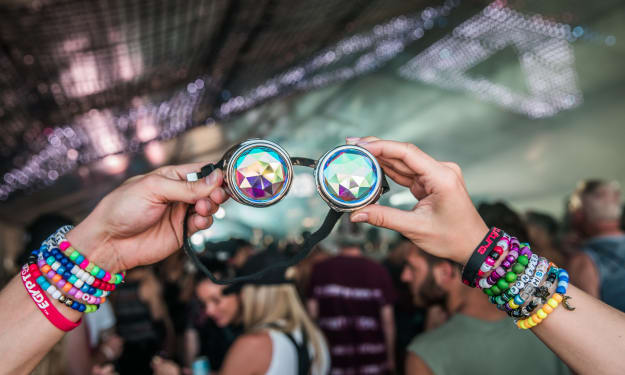10 Forms of Underground Japanese Fashion We Miss
Underground Japanese fashion was one of the most notable aspects of Tokyo's youth culture in the 90s. Now that 2018 is here, we're going to tip our hats to the mo.

Japan is a nation whose culture is known for placing a heavy emphasis on conformity, but that's not always the case. Though the country's mainstream culture is often known for placing a very high amount of respect for conforming to social standards, Japan's youth culture is a different story.
Japan's youth culture has long been known for having a rebellious, stylish, and at times, bizarre streak that remains acclaimed by fashion designers, pop culture aficionados, and artists of all kinds.
Youth culture in Japan isn't quite like American youth culture. While there are still definite subcultures that are defined by clothing and music, Japanese youth culture remains a mostly underground movement. It also tends to be more extreme than what we see stateside.
Truth be told, Japanese youth culture has died down in recent years. Even Fruits, one of the most popular Japanese street fashion magazines dedicated to underground fashion, shuttered its doors in recent years, has closed for good.
If you ask us, this is pretty terrible news. Here are some of the underground Japanese fashion styles that have come and gone, but will hopefully return in full swing once more.
Elegant Gothic Lolita was one of the most visibly recognizable underground Japanese fashions in the past three decades. Known for prizing very pale skin, doll-like clothing, and having an emphasis on Victorian stylings.
This styling has a close tie to the visual kei music scene, and became so popular, the fashion trend splintered into a variety of different "mini scenes." These scenes included Sweet Lolita, Elegant Gothic Aristocrat, Gore Lolita (gurolita) and White Lolita (shirolita).
Unlike what the name may suggest, there's nothing sexual about this dress style. It's a statement about formality in many cases. Though it has become far less common to see, Elegant Gothic Lolita still is around—and so is the most popular EGL publication, the Gothic Lolita Bible.
Gyaru, which is a way of saying "Gal," might just be one of the most unusual underground Japanese fashion trends to make it to America—if you look at festival clothing, anyway.
Most Americans would never guess that this is a counterculture style, but think again. The big counterculture punch that gyaru have is the fact that they tan religiously, a huge rebellion in a country that prizes pale skin.
This subculture is really tied to Japan's nightlife and members love to do para para dances. Though the clothing is very festival-friendly, the skin tones tend to give the overall look a very unique vibe.
Gyaru was a lot more overstated in the 90s and 00s, but as time passed, it died down to a more ritzy and elegant look. Today, gyaru girls are known for a French-inspired look with a California vibe.
Ganguro is a more extreme form of gyaru that is so distinct, it's worthy of its own entry on this list, and places a much heavier emphasis on nightlife. Fluffy boot leggings, bright colors, and giant hair styles are the norm in this fashion style.
While regular "gal" fashion tends to involve more natural-looking colors, ganguro is meant to involve far more contrast than its predecessors. It's meant to be LOUD.
It's not unusual for ganguro girls to contrast bleach blonde (or cotton candy-colored) hair with extremely dark foundation and white lipstick. They also may use white eyeshadow to create a more "panda faced" appearance.
Known for being extroverted, sexy-cute and extremely big fans of dance, ganguro is a subculture that is not for the faint of heart. They love the "fake tan" look, and often will add face gems to their look to tie the outfit theme together.
While many types of underground Japanese subcultures are low-key embraced, this is considered to be a more controversial style due to (untrue) rumors of it being tied to prostitution.
If you thought ganguro was extreme, wait until you see the late-90s trend of yamanba. Loosely translated as "mountain hag," this is one of the most unmistakeable underground Japanese fashion trends out there.
Heavy tanning, extreme piercings, neon-hued hair teased to high heaven, bright white circles around the eyes, and bleach-white lipstick are common themes. Most also will wear kandi bracelets, neon accessories, platform shoes, and of course, animal pajamas outside.
Say what you will, but their individuality definitely gives them a name for themselves.
Decora is a relatively new member among underground Japanese fashion trends. Taking a cue from old-school yamanba culture and US rave culture, decora is all about bringing bright colors and children's accessories to adult fashion.
With decora, the more hair clips, bracelets, and beads you have, the better dressed you are. Facemasks, even band-aids, are often used as decoration. Both men and women in this trend love pastel colors and pink—a very striking difference from mainstream culture!
If you can't tell, a lot of underground Japanese fashion trends involve cuteness in one way or another. The most recent trends to have hit (and possibly peaked) are yume kawaii and yame kawaii.
Yume kawaii is all about pastel colors, stars, unicorns, and magical girl goods. Unlike other underground styles, this is a lot more casual and streetwear-oriented. Yame kawaii is the darker streetwear version of yume kawaii, with much more black elements, greys, and more gloomy visuals.
Both have started to bleed into American streetwear styles.
Both a music scene and one of the most well-known underground Japanese fashion trends in history, visual kei is hard to understand for many Westerners. The best way to explain it is that it's fashion that's inspired by Japanese rock and Japanese metal.
This often-male fashion movement typically features anime-like hair styles, extremely elaborate outfits, special effects contact lenses, and androgynous aesthetics. The best way to describe it is "glam rock from Japan."
Visual kei music videos nail the fashion perfectly, and if you have a thing for K-pop bands like BTS, you probably already know this style well from conventions. 'Nuff said.
Much like visual kei, bosozoku isn't just a fashion statement. Rather, it's a fandom that is heavily focused on extreme car modifications. Follower of this fandom tend to love racing jackets, jumpsuits with car group logos emblazoned on them, and wild pompadour hairstyles.
Don't laugh at their style, though. Bosozoku tend to roll in biker gangs, with many of them proudly showing which crew they run with on their clothing.
Cyber kei, most commonly just known as "cyber,"is the closest thing to pure PLUR-toting happy hardcore rave culture that has ever hit Japan. There are two main schools of cyber that were common in the country.
The first incarnation of this subculture and fashion trend involves loads of Kandi bracelets, fluffy neon outfits and puffy neon hair. Unlike yamanba, extreme makeup and blackface isn't really involved.
The other form involves extremely futuristic streetwear, not unlike the items that Americans would call "streetgoth." Both tend to carry festival essentials with them, so it's really just a very festival-friendly way to live life.
Shironuri might be the most bizarre of all underground Japanese fashion trends to have hit stores in ages. While gyaru and other similar styles emphasized tanning or even using blackface as a way to darken up skin, shironuri does quite the opposite.
Using traditional Japanese geisha makeup and light pastel eyeshadows, people who work this trend turn themselves into ghostly white entities. The clothes, which are often very fairy-like in their stylings, only add to the haunting beauty it is supposed to create.
About the Creator
Skunk Uzeki
Skunk Uzeki is an androgynous pothead and a hard partier. When they aren't drinking and causing trouble, they're writing articles about the fun times they have.






Comments
There are no comments for this story
Be the first to respond and start the conversation.